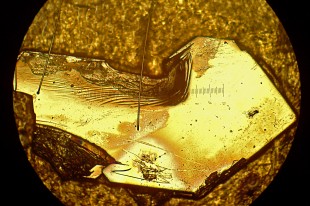Jan 29 2016
Physicists from the United States, China and Germany have found that nuclear effects induce superconductivity in ytterbium dirhodium disilicide (YRS), one of the most-researched materials in the “heavy fermions” class.
 This microscopic closeup shows a small sample of ytterbium dirhodium disilicide, one of the most-studied "heavy fermion" composites. The scale bar in the center of the screen is one millimeter wide. (Photo courtesy of Marc Tippmann/Technical University of Munich)
This microscopic closeup shows a small sample of ytterbium dirhodium disilicide, one of the most-studied "heavy fermion" composites. The scale bar in the center of the screen is one millimeter wide. (Photo courtesy of Marc Tippmann/Technical University of Munich)
The discovery, featured in this week’s Science, shows for the first time superconductivity effect in YRS. YRS is a composite material and has been studied for over 10 years to probe the quantum effects that are thought to effect high-temperature superconductivity.
According to Qimiao Si, Rice University physicist and study co-author, the research offers further evidence that “quantum criticality” causes unconventional superconductivity.
There is already compelling evidence that unconventional superconductivity is linked in both copper-based and iron-based high-temperature superconductors to quantum fluctuations that alter the magnetic order of the materials at ‘quantum critical points,’ watershed thresholds that mark the transition from one quantum phase to another. This work provides the first evidence that similar processes bring about superconductivity in the canonical heavy-fermion system YRS.
Qimiao Si, Physicist, Rice University
Electrons come under a quantum category known as fermions. Heavy fermions contain rare earth elements, and are also composite materials. They are named due to the face at very low temperatures, such as below 1 K, electrons travel through the material as if they were 1,000 times bigger than normal. In the recent experiments due to the measured heat capacity, the electrons behaved such that they were heavier still — about 1,000,000 times. This occurs when the YRS is cooled to just above point of superconductivity, around 2 mK.
Si, a Harry C. and Olga K. Wiess Professor of Physics and Astronomy at Rice, is also the director of the Rice Center for Quantum Materials (RCQM). The research was a collaborative effort with RCQM partners in China and Germany. Experiments were carried out at the Walther Meissner Institute for Low Temperature Research, Bavarian Academy of Sciences, Garching, Germany, and the Max Planck Institute for Chemical Physics of Solids, Dresden, Germany. Theoretical work was carried out at Rice, and the Renmin University of China, Beijing.
Experiments under the supervision of Meissner Institute’s Erwin Schuberth and Max Planck Institute’s Frank Steglich provided an initial glimpse of YRS’ activity at the quantum critical point. Schuberth, who works at the two institutes, and at the Technical University of Munich, said the apparent increased mass provided a hint that nuclear forces were active.
Nothing else could have accounted for such a large change
Erwin Schuberth, Technical University of Munich
Most of the experiments were conducted in Garching, where Schuberth’s team utilized a “adiabatic magnetic cooling” and a few other techniques to make YRS samples ultracold - about 10 times colder than those in earlier YRS experiment - this enabled the discovery of superconductivity in YRS.
In examining the evidence, Si and Rong Yu, fellow theorist at Renmin University, realized that the array of inertial spins of the ytterbium nuclei in the YRS composite results in superconductivity. He said the nuclear spins are coupled at very low temperatures, and arrange themselves in a specific pattern that show the quantum criticality of the electrons.
In YRS, the spins of electrons are locked in a pattern that varies periodically in space and is the hallmark of an electronic order known as anti-ferromagnetism. An ordered arrangement of the nuclear spins acts to suppress the electronic order, and this exposes the electronic quantum criticality, which in turn drives unconventional superconductivity.
Qimiao Si, Physicist, Rice University
The superconductivity discovery in YRS was preceded by a search, which lasted for more than a decade. Steglich said the initial experiments show that quantum criticality in YRS moves electrons to the verge of being localized and itinerant, a state that had been predicted by Si and his collaborators in 2001.
In previous experiments, an external magnetic field revealed a quantum critical point with a host of truly remarkable electronic properties that had been predicted by theory. But the magnetic field also created a condition that is inhospitable to superconductivity.
Frank Steglich, Max Planck Institute
The present work was successful in noticing superconductivity, by achieving quantum criticality by the ordering of nuclear spins at extremely low temperatures, without the application of an external magnetic field.
It is remarkable that it takes an act of nuclear spins to produce quantum criticality at zero magnetic field and realize superconductivity.
Frank Steglich, Max Planck Institute
According to Si, the new findings are vital for the study of heavy-fermion superconductivity, and of the physics underlying quantum criticality.
The work demonstrates that quantum criticality is a robust mechanism for bringing about unconventional superconductivity, not only in high-temperature superconductors, as had previously been shown, but also in heavy-fermion materials that are the canonical example of quantum critical behavior in every other respect.
Qimiao Si, Physicist, Rice University
Study co-authors include Marc Tippmann of the Meissner Institute; Lucia Steinke of the Meissner Institute and the Max Planck Institute for Chemical Physics of Solids; Stefan Lausberg, Alexander Steppke, Manuel Brando and Christoph Geibel, all of the Max Planck Institute for Chemical Physics of Solids; and Cornelius Krellner of the University of Frankfurt and the Max Planck Institute for Chemical Physics of Solids.
The research received support from the German Research Foundation, the Robert A. Welch Foundation and the National Science Foundation.
Source: http://news.rice.edu/